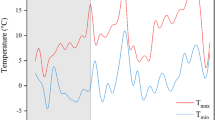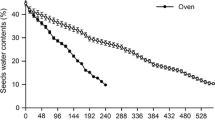Abstract
Cytological and physiological changes during cryopreservation were studied in maize embryos at 35 days after pollination (DAP). Both dehydration and freezing caused cytological damage, such as plasmolysis, swelled mitochondria, increased heterochromatin, and nuclear shrinkage. Dehydration alone slightly impaired plasma membrane integrity while a drastic increase in electrolyte leakage was observed after freezing of embryos with moisture content above 23%. Damage to cellular ultrastructure and plasmalemma integrity was negatively related to moisture content in unfrozen embryos and positively related in frozen embryos. The pattern of changes in activity of antioxidant enzymes differed from one another during dehydration and/or freezing–thawing treatment. Dehydration increased activity of ascorbate peroxidase (APX) and glutathione reductase (GR) but decreased activity of superoxide dismutase (SOD) and dehydroascorbate reductase (DHAR). Freezing further decreased GR and SOD activity and resulted in extremely low DHAR activity. Embryos at intermediate moisture contents had low catalase (CAT) activity before freezing but highest CAT activity after freeze–thaw. Both dehydration and freezing promoted membrane lipid peroxidation which resulted in an approximately threefold increase at most in the malondialdehyde content in postthaw embryos. Changes in viability of postthaw embryos can be closely related to damage in cellular ultrastructure and plasmalemma integrity but directly related neither to antioxidants nor lipid peroxidation levels.






Similar content being viewed by others
Abbreviations
- APX:
-
Ascorbate peroxidase
- CAT:
-
Catalase
- DAP:
-
Days after pollination
- DHAR:
-
Dehydroascorbate reductase
- GR:
-
Glutathione reductase
- MC:
-
Moisture content
- MDA:
-
Malondialdehyde
- ROS:
-
Reactive oxygen species
- SOD:
-
Superoxide dismutase
References
Aebi H (1984) Catalase in vitro. Method Enzymol 105:121–126
Anderson MD, Prasad TK, Stewart CR (1995) Changes in the isozyme profiles of catalase, peroxidase and glutathione reductase during acclimation to chilling in mesocotyls of maize seedlings. Plant Physiol 109:1247–1257
Arrigoni O, Gara LD, Tommasi F, Liso R (1992) Changes in the ascorbate system during seed development of Vicia faba L. Plant Physiol 99:235–238
Bailly C, Benamar A, Corbineau F, Côme D (1996) Changes in malondialdehyde content and in superoxide dismutase, catalase and glutathione reductase activities in sunflower seeds as related to deterioration during accelerated aging. Physiol Plant 97:104–110
Bailly C, Benamar A, Corbineau F, Côme D (1998) Free radical scavenging as affected by accelerated ageing and subsequent priming in sunflower seeds. Physiol Plant 104:646–652
Beauchamp C, Fridovich I (1971) Superoxide dismutase: improved assays and an assay applicable to acrylamide gels. Anal Biochem 44:276–287
Benson EE (1988) Chemiluminescence in cryopreserved plant tissue culture: the possible involvement of singlet oxygen in cryoinjury. Cryo-Lett 9:120–131
Benson EE, Bremner D (2004) Oxidative stress in the frozen plant: a free radical point of view. In: Fuller BJ, Lane N, Benson EE (eds) Life in the frozen state. CRC Press, Boca Raton, pp 206–241
Benson EE, Lynch PL, Jones J (1992) The detection of lipid peroxidation products in cryoprotected and frozen rice cells: consequences for post-thaw survival. Plant Sci 85:107–114
Boucaud M, Cambecedes J (1988) The use of 1,2-propanediol for cryopreservation of recalcitrant seeds: the model case of Zea mays imbibed seeds. Cryo-Lett 9:94–101
Bradford MM (1976) A rapid and sensitive method for the quantitation of microgram quantities of protein utilizing the principle of protein–dye binding. Anal Biochem 72:248–254
Fleck RA, Day JG, Clarke KJ, Benson EE (1999) Elucidation of the metabolic and structural basis for the cryopreservation recalcitrance of Vaucheria sessilis. Cryo-Lett 20:271–282
Fujikawa S (1995) A freeze-fracture study designed to clarify the mechanisms of freezing injury of membranes in cortical parenchyma cells of mulberry. Cryobiology 32:444–454
Ginnopolitis CN, Ries SK (1977) Superoxide dismutase. I. Occurrence in higher plants. Plant Physiol 59:309–314
Goel A, Goel AK, Sheoran IS (2003) Changes in oxidative stress enzymes during artificial ageing in cotton (Gossypium hirsutum L.) seeds. J Plant Physiol 160:1093–1011
Grout BB (1979) Low temperature storage of imbibed tomato seeds: a model for recalcitrant seed storage. Cryo-Lett 1:71–76
Grout BWW, Morris GJ, Clarke A (1980) Changes in the plasma membrane of Chlamydomonas following freezing and thawing. Cryo-Lett 1:251–256
Gusta LV, Rajashekar C, Chen PM, Burke MJ (1982) Freeze induced membrane permeability changes in winter rye. Cryo-Lett 3:27–40
Heath RL, Packer L (1968) Photoperoxidation in isolated chloroplasts. I. Kinetics and stoichiometry of fatty acid peroxidation. Arch of Biochem Biophys 125:180–198
Hodges DM, de Long JM, Forney CF, Prange RK (1999) Improving the thiobarbituric acid-reactive-substance assay for estimating lipid peroxidation in plant tissue containing anthocyanin and other interfering compounds. Planta 207:604–611
Hor YL, Kim YJ, Ugap A, Chabrillange N, Sinniah UR, Engelmann F, Dussert S (2005) Optimal hydration status for cryopreservation of intermediate oily seeds: Citrus as a case study. Ann Bot 95:1153–1161
Iljin WS (1957) Drought resistance in plants and physiological processes. Annu Rev Plant Physiol 8:257–274
Isaacs C, Mycock D (1999) Ultrastructural effects of early imbibition and cryostorage on Zea mays L. root meristems. Cryo-Lett 20:183–192
Kaurin A, Stushnoff C (1985) Influence of dimethyl sulfoxide on freezing resistance of lettuce seeds. Cryobiology 22:569–573
Kermode AR, Finch-Savage BE (2002) Desiccation sensitivity in orthodox and recalcitrant seeds in relation to development. In: Black M, Pritchard HW (eds) Desiccation and survival in plants: drying without dying. CAB International, Wallingford, pp 149–184
Kibinza S, Vinel D, Côme D, Bailly C, Corbineau F (2006) Sunflower seed deterioration as related to moisture content during ageing, energy metabolism and active oxygen species scavenging. Physiol Plant 128:496–506
Lee DH, Lee CB (2000) Chilling stress-induced changes of antioxidant enzymes in the leaves of cucumber: in gel enzyme activity assays. Plant Sci 159:75–85
Lepock JR, Keith AD, Kruuv J (1984) Permeability changes in yeast after freeze–thaw damage: comparison to reproductive survival. Cryo-Lett 5:277–280
Liu YB, Wang G, Liu J, Zhao X, Tan HJ, Li XR (2007) Anatomical, morphological and metabolic acclimation in the resurrection plant Reaumuria soongorica during dehydration and rehydration. J Arid Environ 70:183–194
Mazur P (1984) Freezing of living cells: mechanisms and applications. Am J Physiol Cell Physiol 247:125–142
Moore JP, Nguema-Ona E, Chevalier L, Lindsey GG, Brandt WF, Lerouge P, Farrant JM, Driouich A (2006) Response of the leaf cell wall to desiccation in the resurrection plant Myrothamnus flabellifolius. Plant Physiol 141:651–622
Nakano Y, Asada K (1981) Hydrogen peroxide scavenged by ascorbate-specific peroxidase in spinach chloroplasts. Plant Cell Physiol 22:867–880
Pukacka S, Ratajczak E (2005) Production and scavenging of reactive oxygen species in Fagus sylvatica seeds during storage at varied temperature and humidity. J Plant Physiol 162:873–885
Righetti PG (1983) Isoelectric focusing: theory, methodology and applications. In: Work TS, Work E (eds) Laboratory techniques in biochemistry and molecular biology, vol 11. Elsevier, Amsterdam, p 174
Schaedle M, Bassham JA (1977) Chloroplast glutathione reductase. Plant Physiol 59:1011–1012
Stanwood PC, Bass LN (1981) Seed germplasm preservation using liquid nitrogen. Seed Sci Technol 9:423–437
Varghese B, Naithani SC (2008) Oxidative metabolism-related changes in cryogenically stored neem (Azadirachta indica A. Juss) seeds. J Plant Physiol 165:755–765
Vertucci CW, Farrant JM (1995) Acquisition and loss of desiccation tolerance. In: Kigel J, Galili G (eds) Seed development and germination. Marcel Dekker, New York, pp 237–271
Vertucci CW, Berjak P, Pammenter NW, Crane J (1991) Cryopreservation of embryonic axes of an homeohydrous (recalcitrant) seed in relation to calorimetric properties of tissue water. Cryo-Lett 12:339–350
Vicré M, Lerouxel O, Farrant J, Lerouge P, Driouich A (2004) Composition and desiccation-induced alterations of the cell wall in the resurrection plant Craterostigma wilmsii. Physiol Plant 120:229–239
Walters C, Farrant JM, Pammenter NW, Berjak P (2002) Desiccation stress and damage. In: Black M, Pritchard HW (eds) Desiccation and survival in plants. Drying without dying. CABI, Wallingford, pp 263–291
Walters C, Wesley-Smith J, Crane J, Hill LM, Chmielarz P, Pammenter NW, Berjak P (2008) Cryopreservation of recalcitrant (i.e. desiccation-sensitive) seeds. In: Reed BM (ed) Plant cryopreservation: a practical guide. Heidelberg, Springer, pp 465–484
Wen B, Song SQ (2007a) Acquisition of cryotolerance in maize embryos during seed development. Cryo-Lett 28:109–118
Wen B, Song SQ (2007b) Acquisition and loss of cryotolerance in Livistona chinensis during seed development. Cryo-Lett 28:291–302
Wen B, Wang RL, Song SQ (2009) Cytological and physiological changes related to cryotolerance in orthodox maize embryos during seed development. Protoplasma 236:29–37. doi:10.1007/s00709-009-0044-9
Wesley-Smith J (2001) Freeze-substitution of dehydrated plant tissues: artefacts of aqueous fixation revisited. Protoplasma 218:154–167
Acknowledgements
We are grateful to the National Natural Science Foundation of China (grant no. 30571526), the President’s Foundation of the Chinese Academy of Sciences, and Key Laboratory of Tropical Horticultural Plant Resources and Genetic Improvement (Hainan University), Ministry of Education, for funding the research that resulted in this publication.
Conflict of interest
The authors declare that they have no conflict of interest.
Author information
Authors and Affiliations
Corresponding author
Rights and permissions
About this article
Cite this article
Wen, B., Wang, R., Cheng, H. et al. Cytological and physiological changes in orthodox maize embryos during cryopreservation. Protoplasma 239, 57–67 (2010). https://doi.org/10.1007/s00709-009-0083-2
Received:
Accepted:
Published:
Issue Date:
DOI: https://doi.org/10.1007/s00709-009-0083-2




